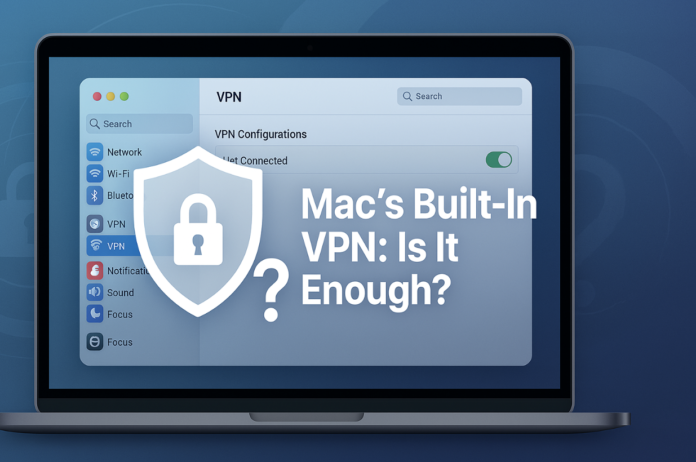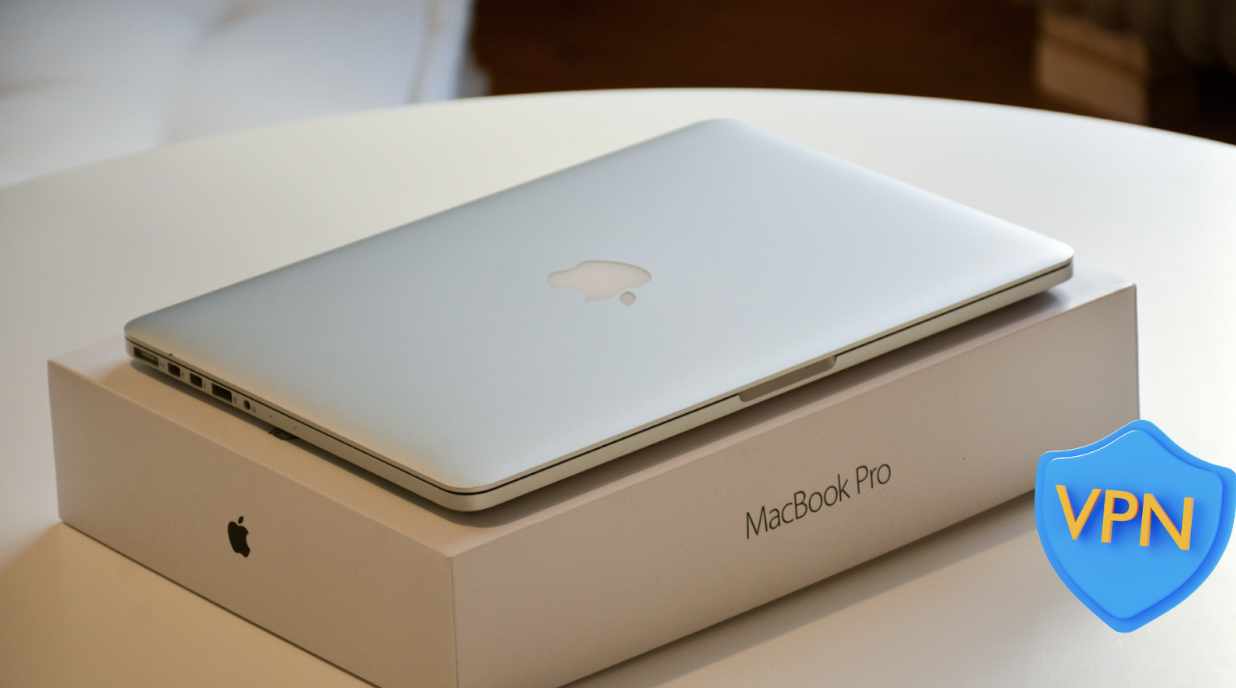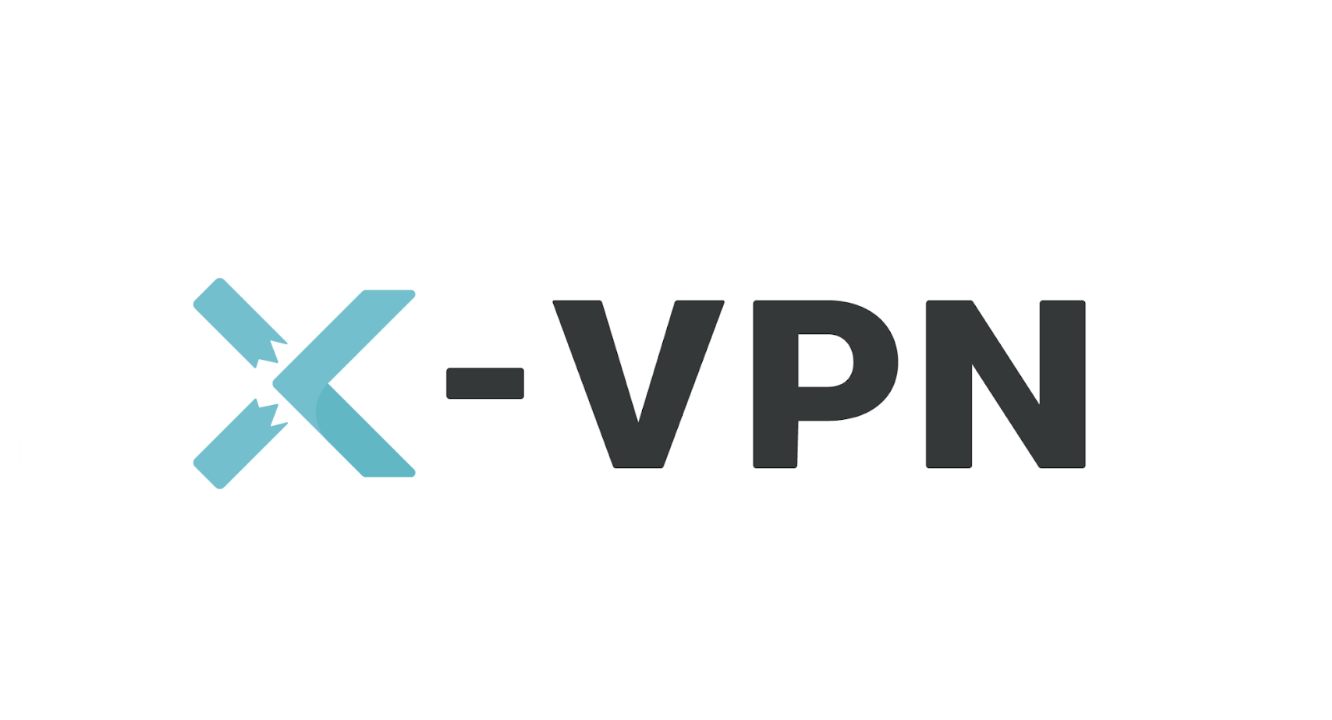Many Mac users assume their device comes with a built-in VPN—after all, Apple is known for its strong focus on privacy.
But while macOS does include some privacy features and VPN support under the hood, that doesn’t necessarily mean you’re fully protected while browsing, especially on public Wi-Fi or when accessing sensitive content.
In this article, we’ll break down what Apple actually offers in terms of built-in VPN capabilities, what iCloud Private Relay does (and doesn’t do), and how it compares to third-party VPN services. If you’ve ever wondered whether you need extra protection on your Mac, this guide will help you decide.
What Is a VPN, and Why Do People Use It?
A VPN, or Virtual Private Network, is a tool that encrypts your internet connection and hides your IP address. For many, it’s the cornerstone of secure, private internet usage—especially when using public Wi-Fi or accessing geo-restricted content.
Using a VPN helps:
- Protect your personal data from being intercepted.
- Mask your online activity from internet service providers and advertisers.
- Bypass geo-blocks to access content from other countries.
- Secure remote work connections, especially for freelancers and digital nomads.
With online privacy becoming more of a concern in 2025, VPNs are no longer just for techies—they’re becoming a daily necessity.
Does macOS Have a Built-In VPN?
Apple devices are known for their privacy-first reputation, which often leads Mac users to ask: “does mac have a built in VPN?”
The short answer? Not quite—but it’s a bit nuanced.
macOS VPN Support (But Not an Active VPN)
macOS does support VPN configurations natively:
- macOS includes built-in support for VPN protocols like IKEv2, L2TP/IPSec, and PPTP (now deprecated).
- You can manually configure these through System Settings > VPN.
- However, there is no one-click, always-on VPN from Apple by default.
Instead of running its own global VPN service, macOS provides the tools for you to connect to third-party VPN services or enterprise VPNs—much like providing the engine but not the fuel.
Common Misconception: “It’s There but Not Activated”
Many users misinterpret the fact that VPN options exist in macOS as meaning Apple provides a VPN service out of the box. But this isn’t the case—you still need a VPN provider or server credentials to actually use it.
Introducing iCloud Private Relay: Apple’s Privacy Layer
In 2021, Apple introduced iCloud Private Relay, a feature bundled with iCloud+ that functions similarly to a VPN—at least on the surface.
So what is it?
How iCloud Private Relay Works:
- Encrypts your web traffic in Safari and hides your IP address from websites.
- Routes traffic through two separate internet relays to protect user identity.
- Prevents both your ISP and the website you visit from knowing your full browsing activity.
Sounds like a VPN, right? Well—not quite.
Key Limitations of Private Relay:
- Only works with Safari browser traffic—apps and third-party browsers like Chrome or Firefox aren’t protected.
- Doesn’t allow server selection (no changing virtual locations or bypassing geo-restrictions).
- No advanced features like kill switches, split tunneling, or full-device encryption.
In short: Private Relay is great for casual privacy enhancement, but not a full VPN replacement—especially for users who need full control over their browsing location or comprehensive protection.
Built-In vs. Third-Party VPNs: What’s the Difference?
Let’s break this down clearly. Here’s how Apple’s approach compares to full-featured VPN services:
| Feature | macOS + iCloud Private Relay | Third-Party VPN (e.g., X-VPN, NordVPN) |
| Full device coverage |  Only Safari (Private Relay) Only Safari (Private Relay) |
 All internet traffic All internet traffic |
| Location spoofing |  Not supported Not supported |
 Choose server/country Choose server/country |
| Encryption |  (Private Relay encrypts Safari DNS & IP) (Private Relay encrypts Safari DNS & IP) |
 (Encrypts all data in/out) (Encrypts all data in/out) |
| Apps protection |  Not covered Not covered |
 Yes, including mail, streaming, social apps Yes, including mail, streaming, social apps |
| Kill switch / emergency disconnect |  No No |
 Available Available |
| Streaming access |  Not supported Not supported |
 Bypass Netflix, BBC iPlayer, etc. Bypass Netflix, BBC iPlayer, etc. |
| Public Wi-Fi protection | Limited | Strong |
Apple’s built-in privacy features are designed to protect casual browser activity, not to function as a robust security suite.
How to Use VPN Features on Mac
If you’re still interested in using the privacy tools your Mac already has, here’s how to make the most of them:
1. Enable iCloud Private Relay
- Go to System Settings > Apple ID > iCloud > Private Relay.
- Toggle it on (requires an iCloud+ subscription).
- Optional: Set IP address location to “Maintain General Location” or “Use Country and Time Zone”.
2. Configure a Manual VPN in macOS
If you have VPN server details (from your work or a third-party service):
- Navigate to System Settings > VPN > Add VPN Configuration.
- Choose the protocol (IKEv2 or L2TP/IPSec).
- Enter your server address, remote ID, and authentication credentials.
- Save and connect when needed.
3. Use a Third-Party VPN App (Easiest Option)
Apps like X-VPN, ProtonVPN, or NordVPN offer:
- One-click connections
- Server selection
- Security enhancements like auto-connect and kill switches
Just download from the App Store or the provider’s site, log in, and protect your whole device instantly.
Do You Still Need a VPN on a Mac?
It depends on how (and where) you use your Mac.
When Apple’s Features Might Be Enough:
- You mostly browse in Safari and use Apple Mail.
- You’re in a low-risk, home Wi-Fi environment.
- You just want basic IP masking and tracking prevention.
When a Full VPN Is a Smarter Choice:
- You work remotely or frequently use public Wi-Fi.
- You stream content from other countries.
- You use apps outside Safari that could expose your data.
- You want the ability to choose your virtual location.
- You travel frequently and need security abroad.
Final Thoughts: Smart Privacy for Mac Users
Apple deserves credit for pushing user privacy forward—but as secure as macOS is, its built-in VPN capabilities are limited.
If you’re a privacy-conscious Mac user, here’s the bottom line:
- iCloud Private Relay is a nice layer of protection—but it’s not a full VPN.
- macOS supports VPNs, but doesn’t come with one pre-installed.
- For users who value full-device encryption, flexibility, and strong public Wi-Fi protection, a third-party VPN is still essential.
In 2025, online privacy isn’t a luxury—it’s a necessity. Whether you’re a freelancer, remote worker, or everyday user, your Mac is only as private as the tools you use with it.
Help keep news FREE for our readers
Supporting your local community newspaper/online news outlet is crucial now more than ever. If you believe in independent journalism, then consider making a valuable contribution by making a one-time or monthly donation. We operate in rural areas where providing unbiased news can be challenging. Read More About Supporting The West Wales Chronicle



























It’s important to note that while macOS allows users to configure VPN connections, it doesn’t provide a built-in VPN service. To fully protect your privacy, subscribing to a reputable third-party VPN service is advisable.